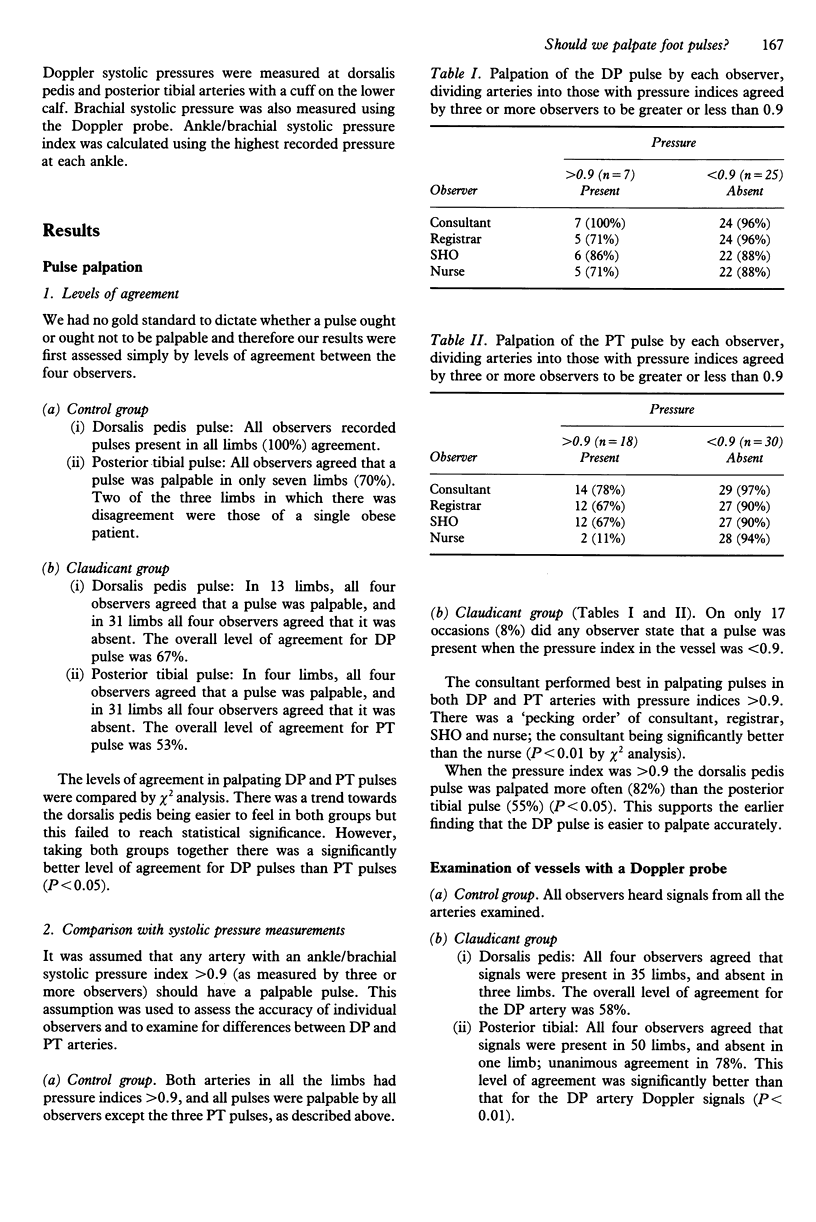Abstract
Palpation of foot pulses is traditionally used to evaluate patients with arterial disease. This study investigated observer variation in assessment of pedal vessels by pulse palpation and Doppler auscultation. A series of 33 claudicant patients and five controls were examined by a consultant, registrar, SHO and nurse. Dorsalis pedis (DP) and posterior tibial (PT) pulses were palpated and were then examined by Doppler with measurement of systolic pressures. Control group: No disagreement in DP pulses. However, all observers agreed on the presence of a PT pulse in only 70% of limbs. Claudicants: There was better agreement in palpation of the DP pulse (all observers agreed in 67% of limbs), than the PT pulse (all agreed in 53%). This suggests that the DP pulse is easier to palpate than the PT (P less than 0.05). By contrast there was better agreement on Doppler signals from the PT artery, all agreed in 78% of limbs; compared with the DP artery, all agreed in 58% (P less than 0.01). Pressure measurements by the observers agreed to within +/- 0.15 in 88% of claudicant and 100% of control limbs. Pedal pulse palpation in patients with arterial disease is subject to substantial observer error. Doppler pressure measurement is preferable unless pulses are bounding.
Full text
PDF


Selected References
These references are in PubMed. This may not be the complete list of references from this article.
- Baker J. D., Dix D. E. Variability of Doppler ankle pressures with arterial occlusive disease: an evaluation of ankle index and brachial-ankle pressure gradient. Surgery. 1981 Jan;89(1):134–137. [PubMed] [Google Scholar]
- Desai S. N. Cleft lip repair in newborn babies. Ann R Coll Surg Engl. 1990 Mar;72(2):101–103. [PMC free article] [PubMed] [Google Scholar]
- LUDBROOK J., CLARKE A. M., McKENZIE J. K. Significance of absent ankle pulse. Br Med J. 1962 Jun 23;1(5294):1724–1726. doi: 10.1136/bmj.1.5294.1724. [DOI] [PMC free article] [PubMed] [Google Scholar]
- Meade T. W., Gardner M. J., Cannon P., Richardson P. C. Observer variability in recording the peripheral pulses. Br Heart J. 1968 Sep;30(5):661–665. doi: 10.1136/hrt.30.5.661. [DOI] [PMC free article] [PubMed] [Google Scholar]
- Myers K. A., Scott D. F., Devine T. J., Johnston A. H., Denton M. J., Gilfillan I. S. Palpation of the femoral and popliteal pulses: a study of the accuracy as assessed by agreement between multiple observers. Eur J Vasc Surg. 1987 Aug;1(4):245–249. doi: 10.1016/s0950-821x(87)80075-0. [DOI] [PubMed] [Google Scholar]


